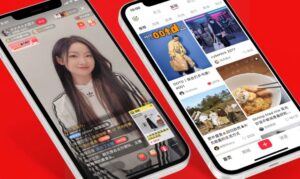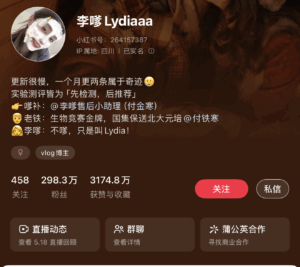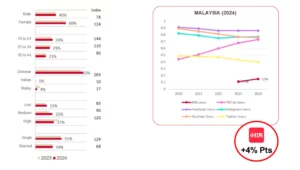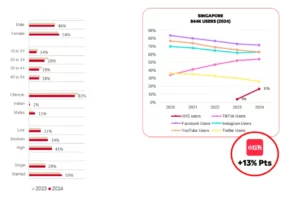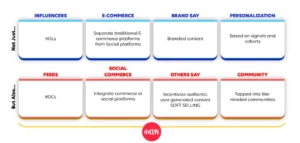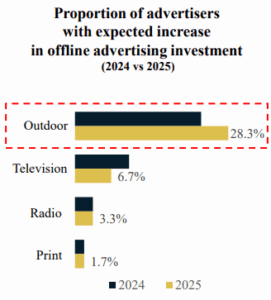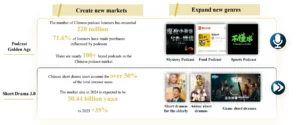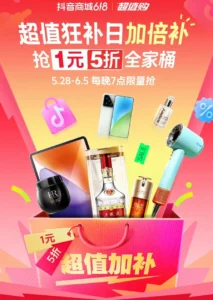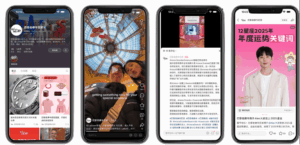RedNote—known in China as Xiaohongshu (“Little Red Book”)—is one of China’s most influential social-commerce platforms. Launched in 2013 by Miranda Qu and Charlwin Mao in Shanghai, it began as a travel and overseas shopping-recommendation community and has since evolved into a comprehensive content and e-commerce ecosystem. Today, RedNote boasts more than 300 million monthly active users and over 50 million daily interactions, shaping consumer behavior in beauty, fashion, lifestyle, and wellness categories across China. Positioned at the intersection of content discovery and commerce, the platform enables users to share real-life experiences while directly influencing purchasing decisions.

What is RedNote?
RedNote functions as a hybrid of social media and e-commerce. Users share “notes”—posts that include photos, short videos, text, product links, and personal stories. Its core lies in authenticity; users favor firsthand experiences and honest product reviews over polished advertising. This organic culture has given rise to the term “planting grass,” referring to inspiring desire and curiosity for products through genuine recommendations.
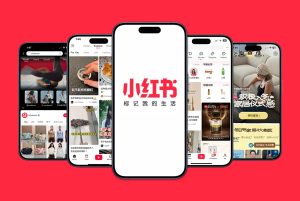
Unlike traditional influencer-driven platforms, RedNote empowers everyday creators to build influence quickly. Content success depends more on credibility and relevance than follower count. Over time, this grassroots model has attracted both consumers and brands, making RedNote a central hub for lifestyle inspiration and community-driven shopping in China.
Key Features of the RedNote App
Explore(FYP)
The Discover tab is the main feed where users browse a curated mix of user-generated content. RedNote’s algorithm tailors this section to each user, displaying posts similar to those they’ve liked or interacted with before. It’s the entry point for discovering lifestyle ideas, beauty tutorials, fashion tips, or travel diaries.
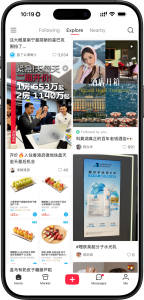
Nearby
The Nearby tab shows posts, people, and products based on the user’s location. It’s commonly used to find local cafés, trending restaurants, or nearby shops. This location-based function strengthens RedNote’s role as a lifestyle search engine, connecting users to experiences around them.
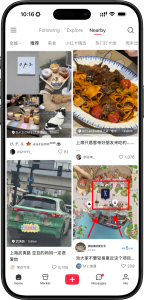
Following
The Followed feed collects the latest posts from accounts users follow, including both individuals and brands. It mirrors a traditional social feed, helping users stay updated with familiar creators while still balancing RedNote’s discovery-driven nature.
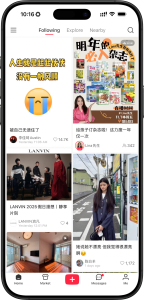
Video Playback Page
This section lets users browse short videos in a format similar to Instagram Reels or TikTok. The focus remains on lifestyle and authenticity—think mini product demos, outfit inspirations, or before-and-after transformations. Each video is paired with comments, tags, and product links to encourage discovery.
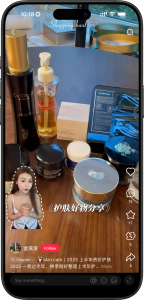
Livestreaming
RedNote integrates livestreaming directly into the app, allowing creators and brands to engage audiences in real time. Users can join live sessions to see product try-ons, Q&A discussions, or event broadcasts. Many livestreams include in-app purchasing, creating an instant path from engagement to conversion.
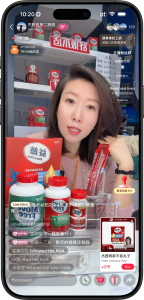
Market
The Market tab is RedNote’s built-in e-commerce platform. Users can browse products, read reviews, and make purchases without leaving the app. Categories span beauty, fashion, home, and tech, reflecting RedNote’s strength in social-driven retail. Although full purchasing options are primarily available in mainland China, international users often use this tab to explore trending products and brands.
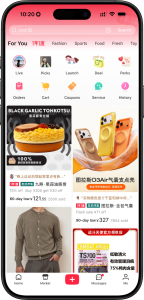
How the RedNote Algorithm Works
Personalization and discovery
RedNote’s recommendation system prioritizes user interest and relevance rather than follower count. It analyzes likes, saves, comments, and viewing behavior to deliver personalized content.
Users discover posts through multiple tabs such as Explore, Nearby, and Search. This mix of interest-based and location-based discovery encourages users to explore new creators and trends.
Implications for content creators
Because RedNote is interest-driven, smaller creators have strong potential to reach large audiences. The platform rewards authenticity and quality over popularity, giving emerging voices more room to grow. However, creators must tailor content to fit the community’s lifestyle focus to maintain engagement.

How RedNote Compares to TikTok and Other Social Platforms
While TikTok focuses on entertainment and short-form viral content, RedNote prioritizes lifestyle storytelling and consumer insights. It predates TikTok by three years and was built with commerce in mind from the start. Unlike TikTok’s single-video vertical feed, RedNote displays multiple posts at once, encouraging browsing, saving, and deeper discovery.
Commerce integration is another major differentiator. TikTok and Instagram often rely on external links for shopping, whereas RedNote enables product browsing, review reading, and in-app checkout, streamlining the consumer journey. At the same time, RedNote enforces stricter moderation aligned with Chinese regulatory standards, especially regarding political or sensitive content.
RedNote vs. Xiaohongshu
RedNote and Xiaohongshu are the same platform. “RedNote” is the name commonly used outside China, while Xiaohongshu is the Chinese name. Most core features, especially content-discovery tools, remain the same. However, in-app shopping and livestream commerce are more accessible inside China due to regulatory and logistic differences.
RedNote and the TikTok Ban: Impact on User Migration
The conversation around a potential TikTok ban in the United States significantly shaped RedNote’s global exposure. As lawmakers intensified scrutiny around data privacy and foreign-owned social platforms in late 2024 and early 2025, millions of U.S. users searched for alternative spaces to create and consume short-form content. During peak speculation, RedNote reportedly saw nearly three million new U.S. user downloads in a single day.

This migration wave marked one of the platform’s largest surges outside China. American creators, particularly those in beauty, wellness, and lifestyle niches, began experimenting with RedNote to diversify audience reach and secure brand partnerships targeting Chinese consumers. The event also sparked increased media coverage and investor interest in China-based consumer platforms, positioning RedNote as a cross-border digital bridge. While TikTok remains dominant globally, the geopolitical moment accelerated early adoption of RedNote in Western markets and expanded cultural exchange on the platform.
International availability and language support of RedNote
RedNote is available globally via iOS, Android, and web browser. Although the interface displays partial English, most user-generated content remains in Mandarin. The platform has introduced translation and automatic subtitle tools, but full English adoption is still in development. International users can browse, post, and engage freely, but shopping features remain primarily localized to China.
Safety, security, and user privacy concerns on RedNote
RedNote operates under Chinese cybersecurity and data-protection regulations. Some governments, particularly in Taiwan and certain Western institutions, have expressed caution or imposed usage limitations on government-issued devices due to data-sovereignty concerns. The platform employs content moderation to enforce community standards and restrict political or sensitive content, prioritizing safety, trust, and platform compliance.
Monetization and opportunities for content creators on RedNote
RedNote does not currently offer direct monetization programs such as ad revenue sharing. Instead, creators earn income through brand collaborations, sponsorships, and affiliate sales.
The Dandelion Program connects verified influencers with brands for campaign opportunities. Verification requires identity checks, such as a passport upload. Music and video usage rules vary by region and are stricter than those on Western platforms.
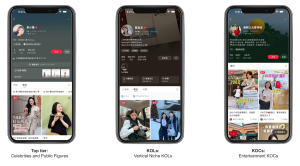
Compared to TikTok, Instagram, and YouTube, RedNote’s monetization system is less developed but growing through partnerships and commerce-based engagement.
How to download and start using the RedNote app
You can download RedNote from the iOS App Store or Google Play, or use it on desktop via Xiaohongshu.com.
To get started:
• Install the app and register with your phone number or email.
• Complete verification if prompted.
• Explore the Explore, Follow, Nearby, and Search tabs.
• Tap the “+” icon to create posts, add text or media, and tag products or locations.
International users may face restrictions on shopping features but can still post and engage with community content.
Frequently asked questions about RedNote
Is RedNote free to use?
Yes. All basic posting and browsing features are free.
What is RedNote app?
It’s a lifestyle and shopping platform combining social media and e-commerce, originally known as Xiaohongshu in China.
Can I shop on RedNote from outside China?
Shopping features are limited for international users, though browsing and product discovery remain open.
Is RedNote safe and how does it handle my data?
RedNote follows Chinese data laws and applies strong moderation to protect the community. Users should review privacy settings carefully.
What is the difference between RedNote and Xiaohongshu?
They are the same app. RedNote is the English name; Xiaohongshu is the Chinese version.
Can I monetize my content on RedNote?
There’s no built-in monetization system. Creators usually earn through brand partnerships or sponsorships.
Is RedNote available in English?
Some menus and interface elements are in English, but most content remains in Mandarin.
How does RedNote’s algorithm differ from TikTok’s?
RedNote focuses on interest-based recommendations. TikTok relies more on previous engagement and followers.
What are the main content restrictions on RedNote?
Political or sensitive topics and non-compliant content may be censored.
How can brands collaborate with creators on RedNote?
Brands can connect through influencer partnerships or the Dandelion Program after identity verification.
Read More
Why RedNote Delivers High ROI for Foreign Brands in China
The Rise of Soft-Selling Livestreams on RedNote
RED Alert: How Brands Can Win On RedNote in Southeast Asia
9 Proven Strategies for Foreign Brands to Succeed on RedNote
6 Keyword Categories Every Brand Needs for Xiaohongshu Success
How to Market to Affluent Chinese Female Travelers Using RedNote





